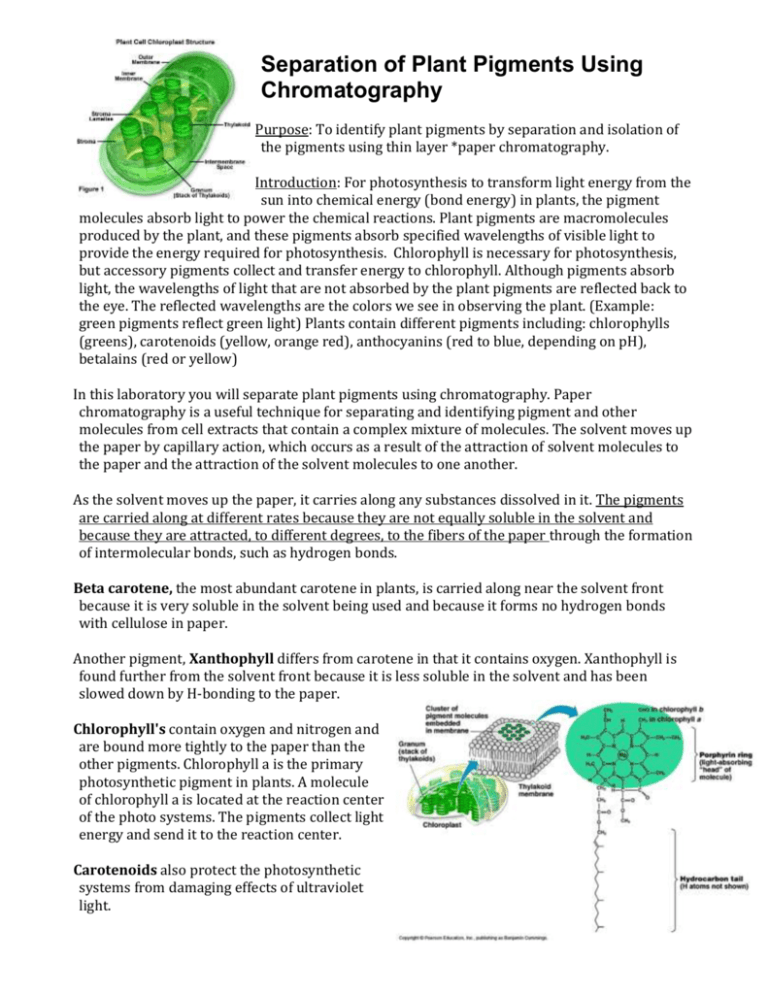Plant Pigment Chromatography Lab: Separation & Identification
advertisement

Separation of Plant Pigments Using Chromatography Purpose: To identify plant pigments by separation and isolation of the pigments using thin layer *paper chromatography. Introduction: For photosynthesis to transform light energy from the sun into chemical energy (bond energy) in plants, the pigment molecules absorb light to power the chemical reactions. Plant pigments are macromolecules produced by the plant, and these pigments absorb specified wavelengths of visible light to provide the energy required for photosynthesis. Chlorophyll is necessary for photosynthesis, but accessory pigments collect and transfer energy to chlorophyll. Although pigments absorb light, the wavelengths of light that are not absorbed by the plant pigments are reflected back to the eye. The reflected wavelengths are the colors we see in observing the plant. (Example: green pigments reflect green light) Plants contain different pigments including: chlorophylls (greens), carotenoids (yellow, orange red), anthocyanins (red to blue, depending on pH), betalains (red or yellow) In this laboratory you will separate plant pigments using chromatography. Paper chromatography is a useful technique for separating and identifying pigment and other molecules from cell extracts that contain a complex mixture of molecules. The solvent moves up the paper by capillary action, which occurs as a result of the attraction of solvent molecules to the paper and the attraction of the solvent molecules to one another. As the solvent moves up the paper, it carries along any substances dissolved in it. The pigments are carried along at different rates because they are not equally soluble in the solvent and because they are attracted, to different degrees, to the fibers of the paper through the formation of intermolecular bonds, such as hydrogen bonds. Beta carotene, the most abundant carotene in plants, is carried along near the solvent front because it is very soluble in the solvent being used and because it forms no hydrogen bonds with cellulose in paper. Another pigment, Xanthophyll differs from carotene in that it contains oxygen. Xanthophyll is found further from the solvent front because it is less soluble in the solvent and has been slowed down by H-bonding to the paper. Chlorophyll's contain oxygen and nitrogen and are bound more tightly to the paper than the other pigments. Chlorophyll a is the primary photosynthetic pigment in plants. A molecule of chlorophyll a is located at the reaction center of the photo systems. The pigments collect light energy and send it to the reaction center. Carotenoids also protect the photosynthetic systems from damaging effects of ultraviolet light. Procedure 1. Obtain a beaker and add about 2 cm of solvent at the bottom. Cover the beaker with a petri dish to prevent the vapors from spreading. 2. Cut a piece of filter or chromatography paper which will be long enough to reach the solvent. Draw a line about 3.0 cm from the bottom of the paper. 3. Use a quarter to extract the pigments from spinach leaf cells. Place a small section of leaf on the top of the pencil line. Use the ribbed edge of the coin to crush the leaf cells. Be sure the pigment line is on top of the pencil line. Use a back and forth movement exerting firm pressure through out. 4. Place the chromatography paper in the cylinder. Do not allow the pigment to touch the solvent. 5. Cover the beaker. When the solvent is about 1 cm from the top of the paper, remove the paper and immediately mark the location of the solvent front before it evaporates. 6. Mark the bottom of each pigment band. Measure the distance each pigment migrated from the bottom of the pigment origin to the bottom of the separated pigment band. Record the distance that each front, including the solvent front, moved in the table below. Depending on the species of plant used, you may be able to observe 4 or 5 pigment bands. The distance traveled by a particular compound can be used to identify the compound. The ratio of the distance traveled by a compound to that of the solvent front is known as the Rf value; unknown compounds may be identified by comparing their Rf's to the Rf's of known standards. Rf equation Analysis: Type of Leaf:________________ 1. Illustrate the results of the chromatogram on the diagram on the right. Label the banks with the correct color and pigment. 2. Complete the table below. Band Color Plant Pigment Yellow to Yellow-orange Carotene Yellow Xanthophyll Bright Green to Blue Green Chlorophyll a Yellow Green to Olive Green Chlorophyll b Distance (mm) Rf (use formula) 3. Why are solvents used in the process? 4. Justify the separation of the bands. Which bands travelled the furthest and why? Make sure the mention hydrogen bonds! 5. Why is energy required for life? 6. How does most energy enter the living world? Write the equations for this reaction. 7. What composes visible white light? 8. How did the results differ with different leaves? 9. How would the results differ if the leaves had been stored in a dark room for five days before the experiment or if the leaves were collected in the fall rather than the spring or summer? Explain your answer? 10. The spinach leaf looks green, but your chromatogram demonstrated that other pigments are in the leaf as well. Why can you not readily see the other pigments in the leaf? 11. What is a benefit of the pigments in photosynthesis?4 12. Why are plants generally green? 13. Would you expect a plant to grow well in only green light? Explain. Appendix: Accepted Rf values for plant pigments.











